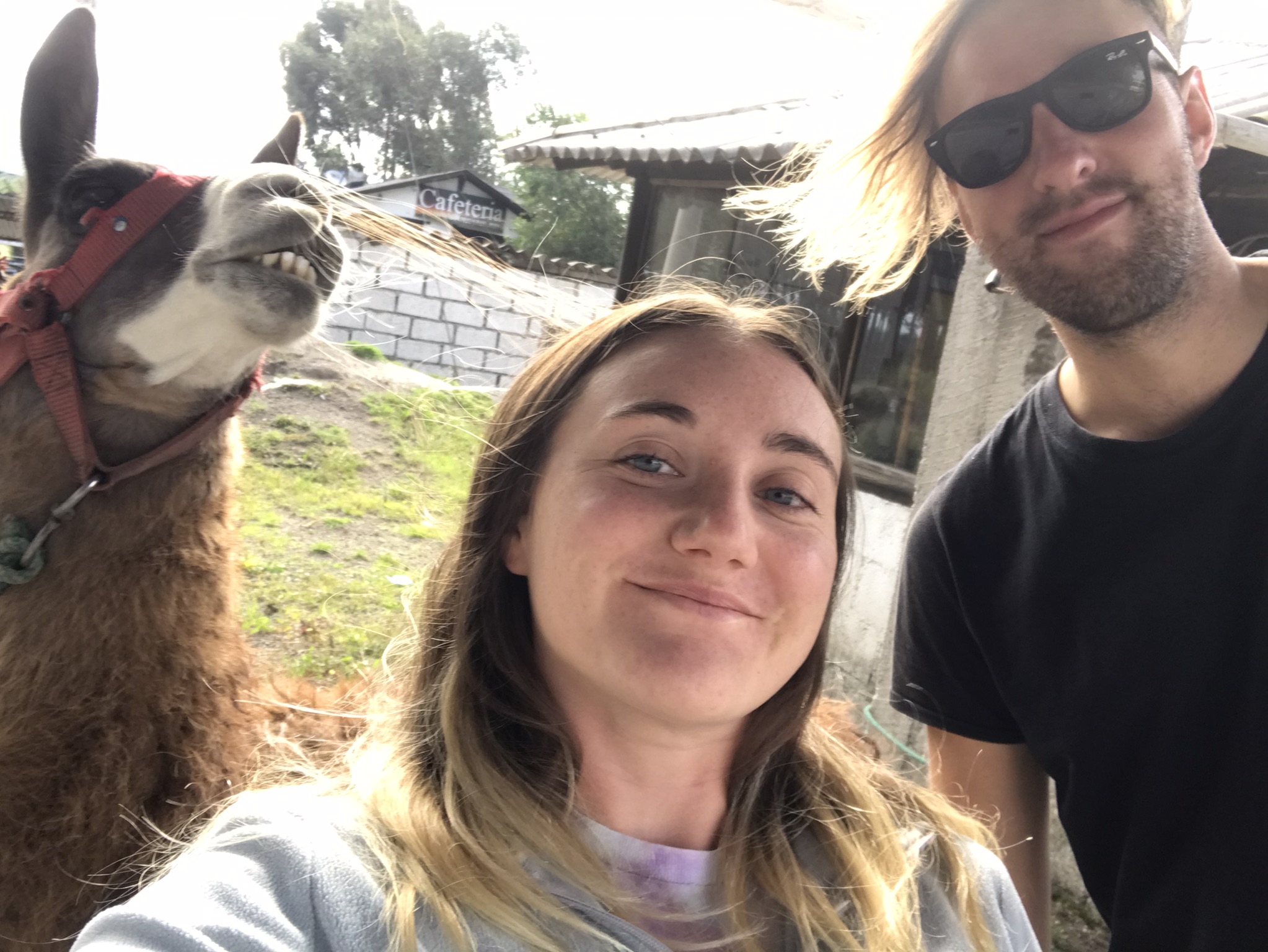Public transport in Central American can be a little complicated. While most South American countries have inter-city bus companies operating out of organised terminals which makes transportation easy, this isn’t always the case in Central America. You may see and hear people talking about a ‘terminal’ in most Central American countries, but in reality this is more likely to just be a large parking lot full of chicken buses. Public transport in Central American can often be slow and uncomfortable, but also cheap, and sometimes a lot of fun! Check out my Central American public transport tips below as well as a country-by-country breakdown based on my own experiences of traveling exclusively by public transport in Central America.
Belize, Guatemala, El Salvador, Honduras, Nicaragua, Costa Rica, Panama
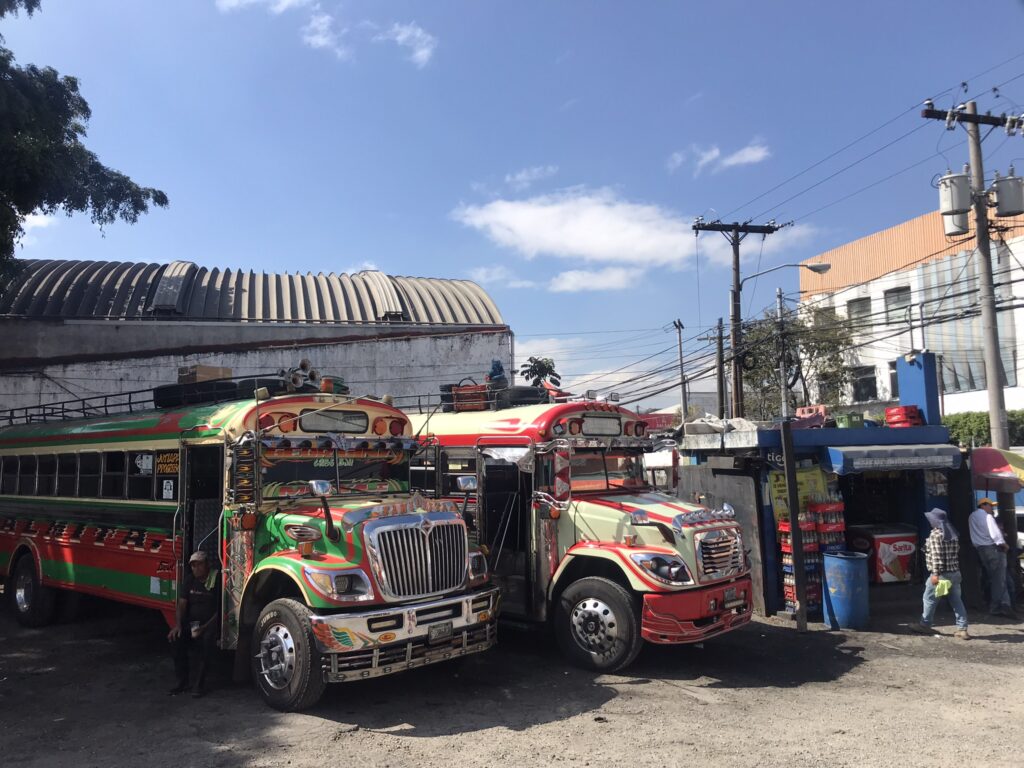
In Central America, the chicken bus is king. If you want to get around cheaply in Central America, then the chicken bus is the way to go. Chicken buses (or ‘camionetas’ as they are known by locals) are repurposed buses that are usually purchased cheaply from wealthier countries. Often these are old American school buses, but we also experienced old tourist coaches from France and even a bus with a load of Japanese writing inside. The chicken buses are typically more informal buses without a ticket office or even a real company behind them. They are known for the often wild and erratic driving of the drivers, garish paint jobs and tendency to blare loud music. Don’t expect air conditioning. The buses usually feature a driver and a conductor who ushers people on and off the bus, collects money, helps with luggage and often spends most of the journey hanging out of the door hollering to passers-by and instructing the driver. There will be virtually no foreigners on the bus and you may see locals transporting strange items such as very large boxes, sacks of potatoes or even live animals such as chickens, hence the name.
While chicken buses are present throughout Central America, their actual nature varies from country to country and even bus to bus. The chicken buses do not have timetables, they generally depart when they are full or when the driver is bored of waiting, however they do follow set routes and usually the buses will stop anywhere that you ask along the route. We found that the conductors were usually quite helpful in getting us to where we needed to go. We also found that they generally did not rip us off for the price or treat us any differently to the locals. One tip if you’re unsure is to ask a local the cost of the journey before getting on the bus. We found everyone including the conductors was usually honest and friendly, but there is always a possibility that an unscrupulous conductor might try to overcharge you. There have also been reports of thefts on chicken buses so don’t let your guard down and keep an eye on your belongings. Generally though the chicken bus is an experience in itself, a great way to mingle with the locals and we had some memorable journeys on the many chicken buses we took in Central America. I even found myself conducting an impromptu English lesson for some locals on a chicken bus in El Salvador!
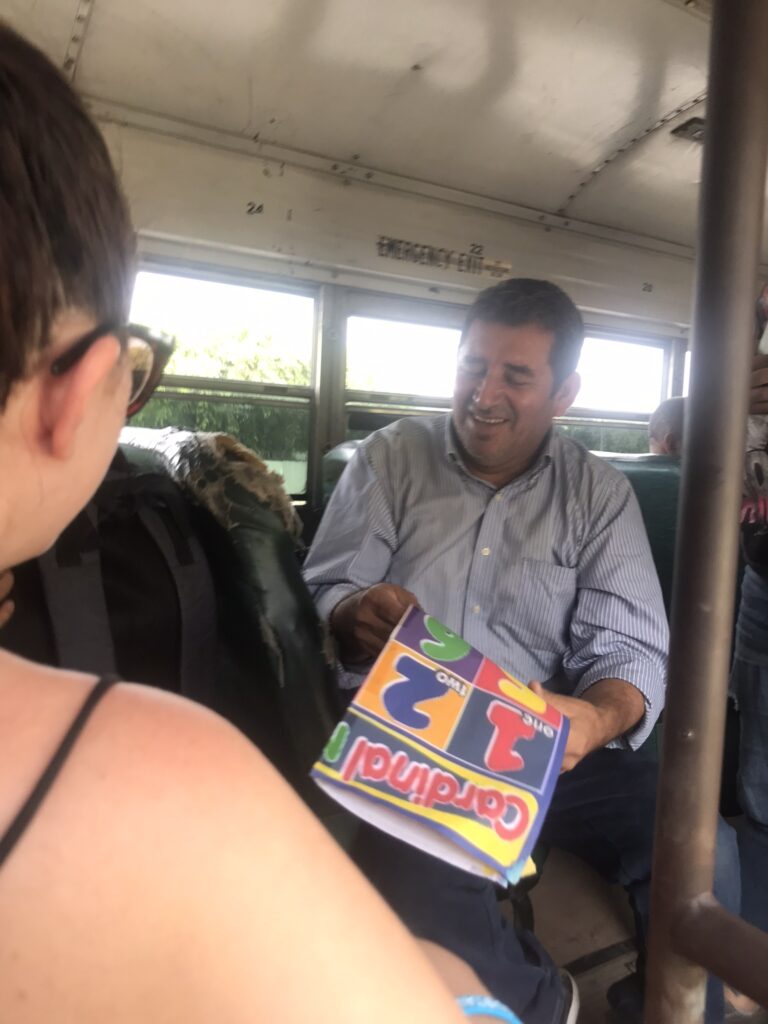
Teaching English on the chicken bus in El Salvador
The luggage situation varies between buses. Some of the buses have overhead luggage racks, in some cases luggage will be stashed on the seats at the back of the bus, while in other cases they will tie the luggage to the roof or even to the front of the bus. On some occasions we needed to ride with the luggage on our laps, which was not always comfortable. The main thing is not to put the luggage on the seat next to you – this is taking up space that could be used by a person, and so the conductor will probably charge you for the seat. Chicken buses tend to cram full of people so even if the seat is free when it sets off, the chances are it won’t be free for the whole journey. We were also charged a little extra on some occasions for storing luggage in the small trunk at the back of the bus. Most of the time though it isn’t a big deal because the buses are usually very cheap anyway, usually no more than a few dollars for a journey lasting hours.
When leaving the bus, it is important to let the conductor know in advance if you are not riding the bus to the end of the line. You are expected to be very quick and efficient while exiting the bus, as it does not want to stop for too long or hold up traffic. People often move towards the front of the bus as they are approaching their stop in order to make a quick exit. At times you might be expected to jump out of the bus while it is still moving slightly!
Along with the chicken buses, Central America also has micros, these are smaller minibuses (usually 16-seater) which operate in the same way as the chicken buses to all intents and purposes but usually will wait until they are full before leaving. The micros are often completely crammed full of people and can be quite uncomfortable, but they are often more direct and faster than the larger chicken buses.
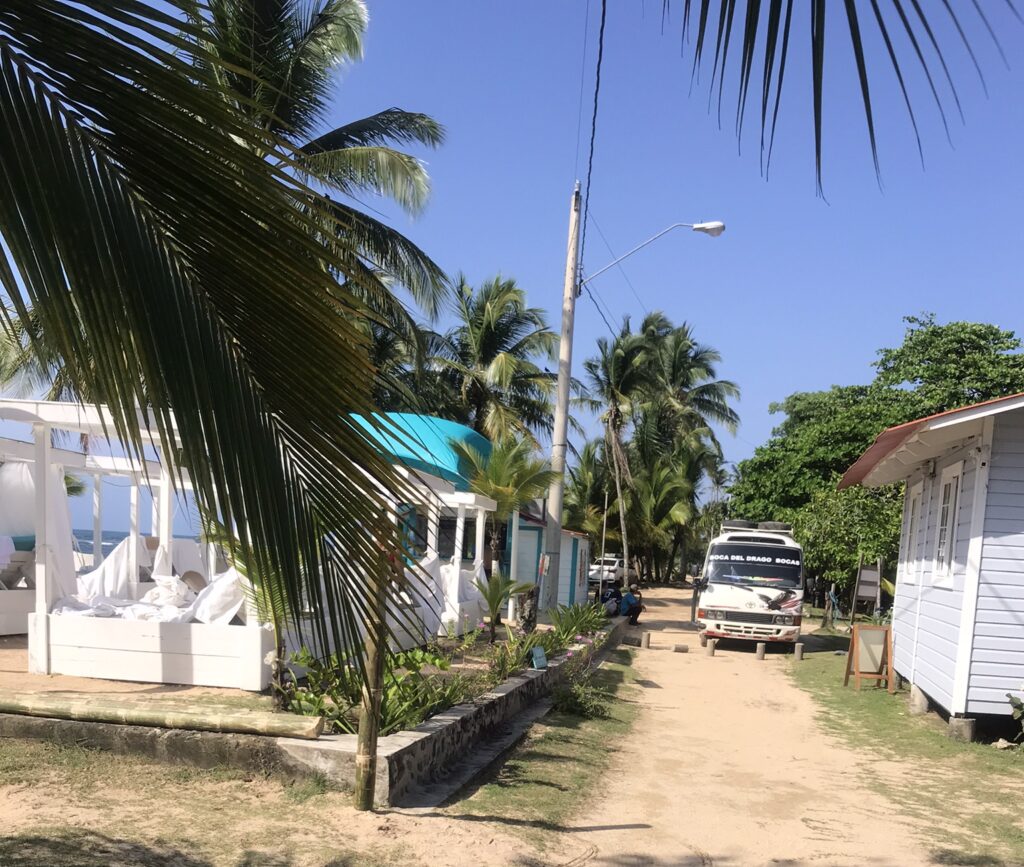
A microbus in Panama
In most countries, the chicken buses and micros will display their final destination in the front window. The bus conductors will often usher you on very quickly so make sure to check that the bus is going to the right place before it sets off. On some occasions we saw locals who had to get off and head back in the other direction as they had jumped on the wrong bus!
Along with the chicken buses and micros, there are some larger coach companies in Central America such as Ticabus and Transportes del Sol. These companies generally operate set routes between Central American capitals and apparently may stop off at towns and cities along the route (although the people in the Ticabus ticket office denied this when we asked them in person). We didn’t personally use these companies as they seemed to be much more expensive than the chicken buses and we couldn’t really get a clear answer when trying to work out where/if they were going to stop. We met some travelers who swore by Transportes del Sol though. There are some other small companies that offer coach travel on certain routes, the larger coaches are sometimes referred to by locals as ‘Pullmans’ however they are quite rare and often do not run at convenient times.
As well as the local public transport, there are also tourist shuttles running between popular tourist destinations in most Central American countries. The tourist shuttles are generally much more expensive than the chicken buses and the service isn’t usually all that much better. The positive is that they will (usually) go directly from A to B without stopping. We copped out and took the tourist shuttles on a couple of occasions for convenience, but generally we avoided them in favour of local transportation when at all possible. It’s more authentic, more fun and above all much cheaper.
While the basics of the chicken buses are the same everywhere in Central America, we found that there were slight differences and variations in each country in terms of the buses themselves, stations, routes and the overall chicken bus experience. Check out my country-by-country breakdown below.
Belize
We found Belize to be one of the easiest countries to get around by chicken bus. There are only three bus routes in the country which all center around Belize City; one running north, one running south and one running west. Bus routes can be found at https://www.belmopanonline.com/belize-bus-schedules. The buses depart regularly, usually leaving every 30 minutes, and most buses will usually run for the whole of the route, all the way to the border and back. The highways in Belize are usually pretty good quality and not too much traffic, so it is easy to get around. We found that Belize City and Belmopan did have bus stations, although they were a little run down and in Belmopan we queued up only to be advised to not bother buying a ticket and just pay on the bus. On one occasion the bus was full and so the conductor told us to wait around the corner so he could pick us up out of view of the police. Generally, in Belize they did not fill the buses quite as full as in other places and did not seem to like people standing up on the bus.
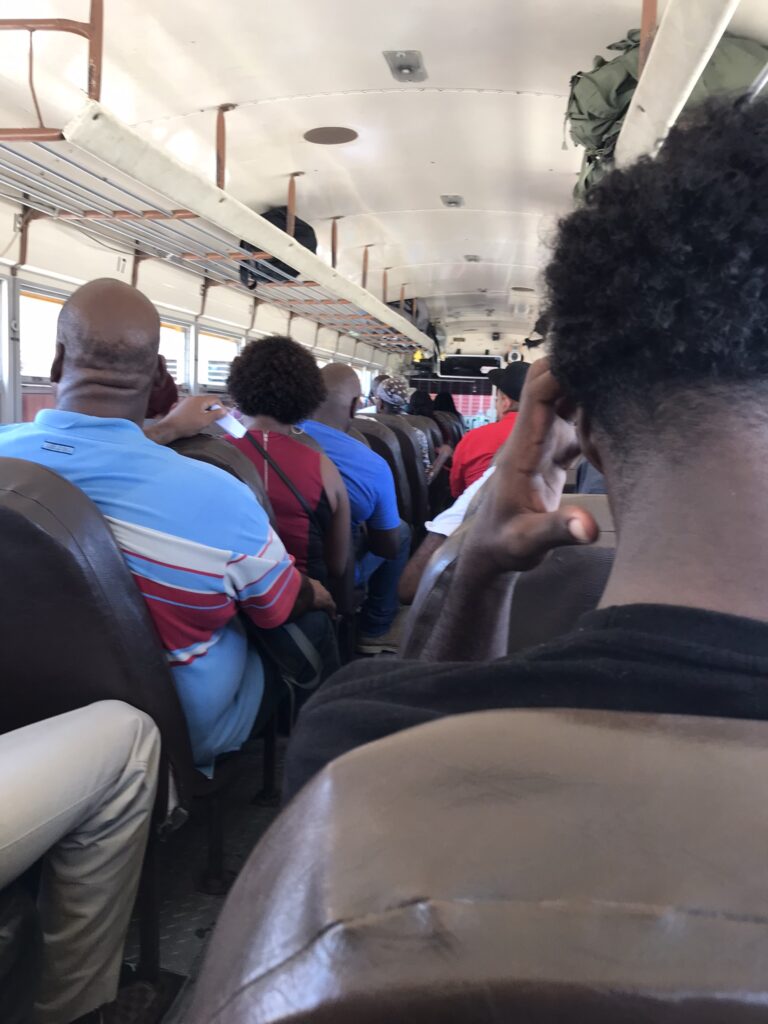
On the chicken bus in Belize
The buses in Belize are usually old American school buses. Luggage is typically put in through the back door of the bus and covers the back two seats, and the back door is then fastened by an unlocked padlock. At times the luggage was not stacked securely and fell onto the people on the seats in front, or fell out of the back of the bus when the back door was opened. We made sure to sit near the back of the bus on each trip to keep an eye on our bags and make sure they didn’t fall out of the bus.
Expect top quality reggae music to be played very loudly on the chicken buses in Belize!
Guatemala
Guatemala is home of the stereotypical chicken buses with garish paint-jobs, crazy driving and blaring music. Usually luggage is either stored on top of the bus, on an overhead rack or on your knees. This usually depends on the skill and enthusiasm of the driver’s assistant.
We found that Guatemala was the most difficult place to negotiate the chicken buses. The bus ‘terminals’ were chaotic and disorganised, the routes were unclear and even a relatively short journey would often require numerous changes and a lot of time spent waiting at the side of the road in some random place. In northern Guatemala around Flores and Semuc Champay we found it difficult to find any accurate information about chicken buses. While we met people who had taken chicken buses from this region to the south of the country, by all accounts this took them a very long time and usually involved an overnight stop along the way. Given the costs and time of an additional overnight stay we sadly decided to fork out for tourist shuttles to get us from Flores to Lanquin and then on to the south – this was actually the easiest and most cost-effective option. We were able to get chicken buses everywhere in the south of Guatemala and most of them were direct. The key is to ask around, set off early enough and hope for a bit of luck.
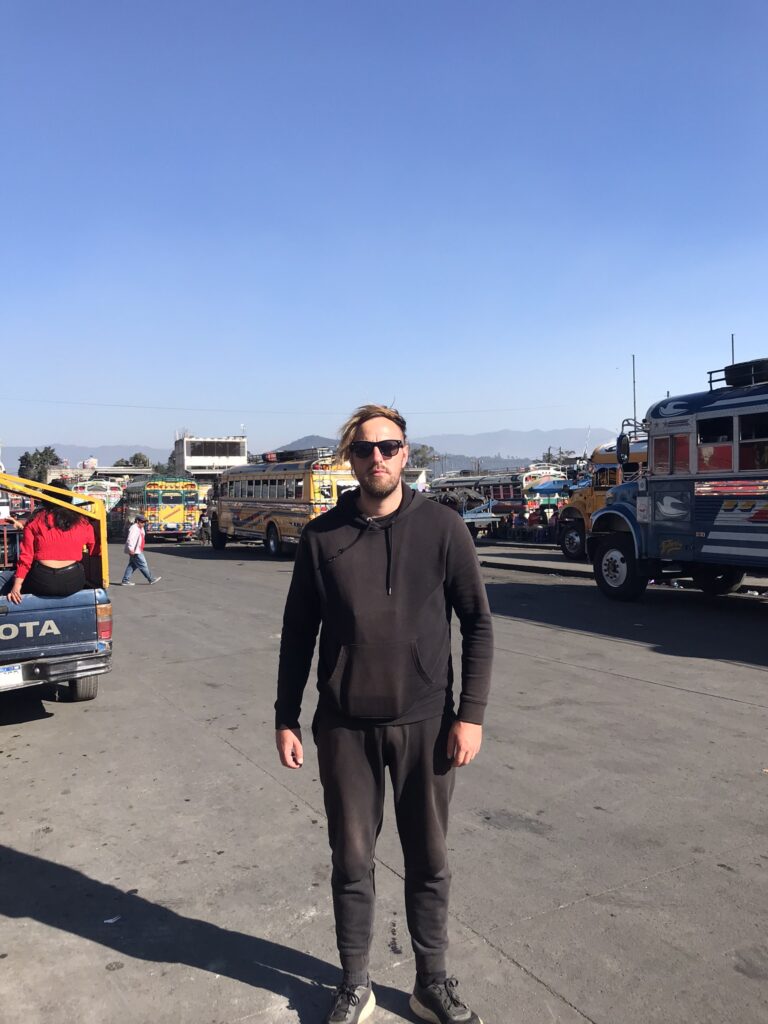
The ‘bus terminal’ in Quetzaltenango
Also be aware that the roads in Guatemala are not great for getting around quickly. There are few highways and a lot of the time it is mountainous, single-lane roads. Although it seems like a small country on the map, getting around can take hours and hours in Guatemala due to the nature of the roads and the inevitable traffic.
In some parts of Guatemala, riding in the back of a pickup truck is considered an acceptable form of public transport. We even saw the police traveling this way! If you do need to travel in the back of a pickup, it’s best to either sit down if possible or otherwise just cling tightly to the metal bars.
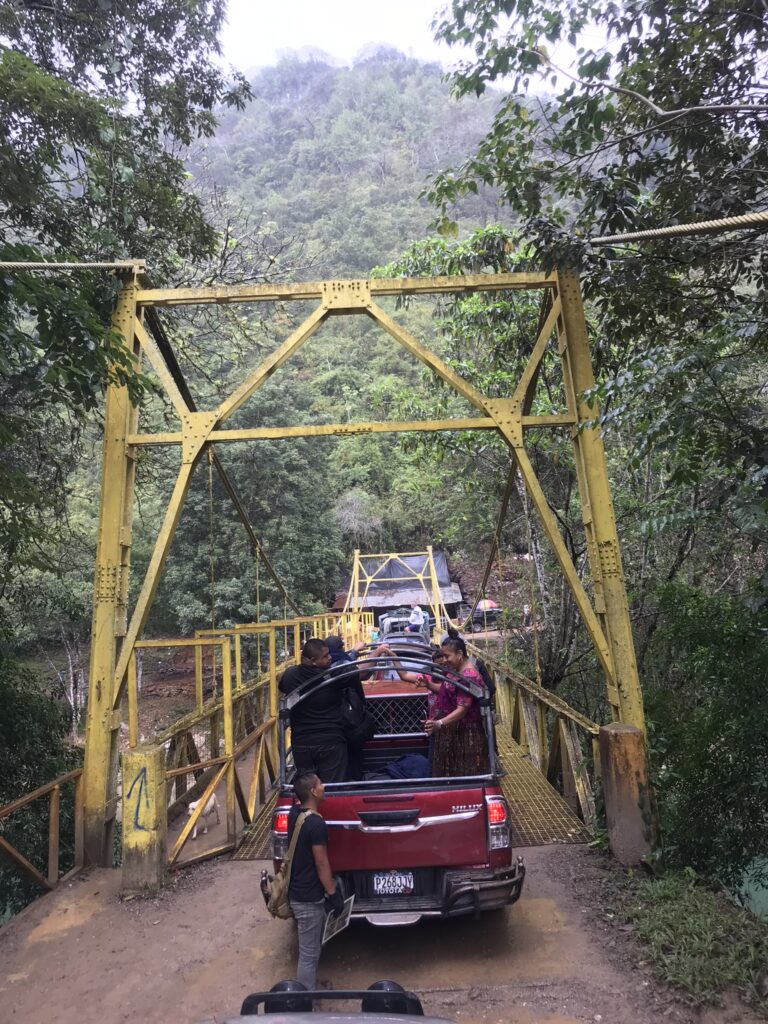
In the back of a truck near Lanquin
El Salvador
We found bus travel in El Salvador to be extremely easy because the bus routes are numbered. Just find out what number bus you need, where it will be departing from and off you go. This also makes it much easier to flag down the correct bus if one is passing. We found that the buses here were more similar to old public-service buses rather than school buses, they usually had built-in bells to tell the driver when to stop and automatic front and back doors with a conductor often running between the two. Sometimes we saw buses randomly change conductors mid-journey. It wasn’t always clear what was going on, who was working and who was just riding the bus.
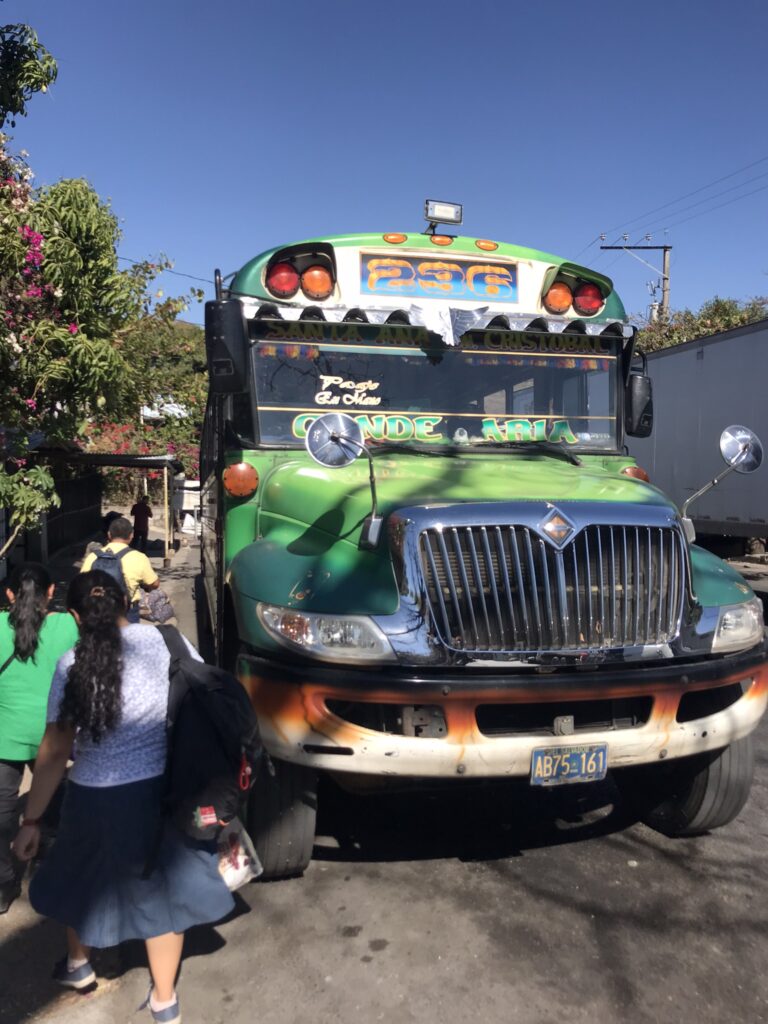
The numbered chicken buses make things easy in El Salvador
Most of the chicken buses in El Salvador did not have luggage storage, but we were usually able to sit near the back doors and stuff our bags somewhere in the space between the doors and barriers, which the conductor was always happy with. Dan often rode standing up with one of the bags between his legs. As long as the conductor doesn’t think you are taking up another passenger’s space then you will be fine, and we didn’t ever have to pay twice.
Honduras
Surprisingly the buses in Honduras were a little more organised than in neighbouring countries, a little more similar to South American buses. Most of the buses belonged to small companies, and the conductor would sometimes even give you a ticket! We also found that in some cases the inter-city buses were actual coaches rather than chicken buses. We took coaches to get between Tegucigalpa and Choluteca and Ocotepeque and San Pedro Sula, we found that the local buses around the Lago Yojoa region were more similar to the usual chicken buses and we also used micros to get between Copan Ruinas and San Pedro Sula, Santa Rosa and La Entrada and Choluteca and the border with Nicaragua.
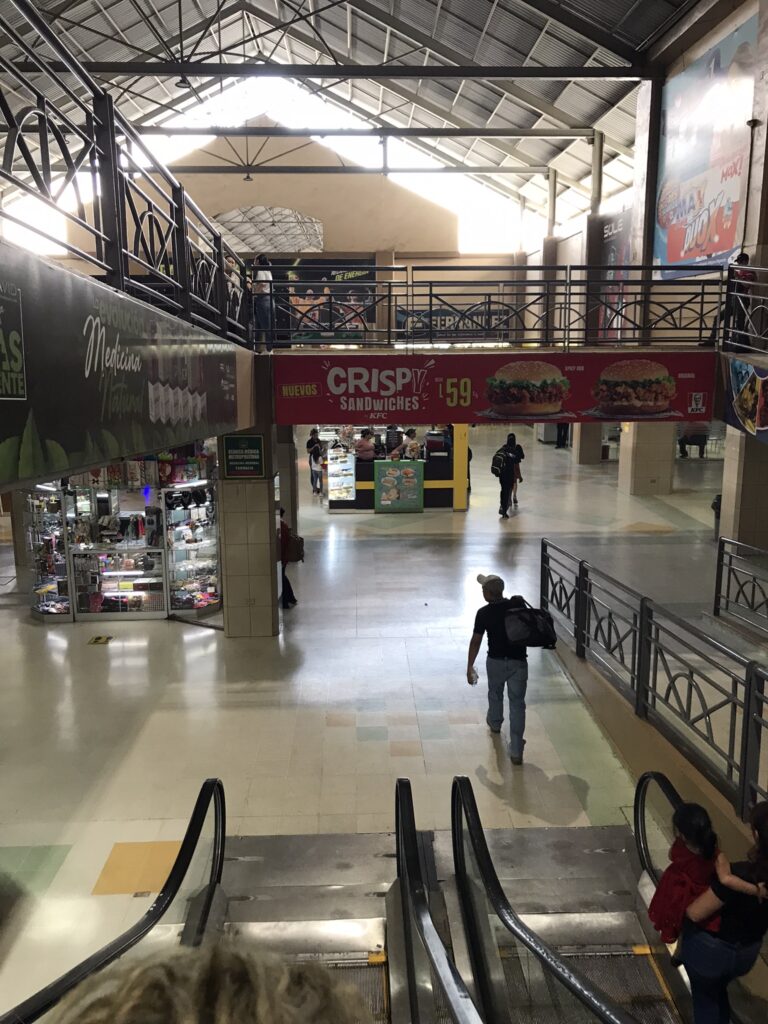
Inside the huge bus terminal in San Pedro Sula
Many buses in Honduras transfer through San Pedro Sula, which is a city with a notorious reputation as one of the most dangerous places in the world. The good news is that the bus terminal in San Pedro Sula is the largest and most organised in Central America. If you are transferring buses there you won’t need to go near the city itself. Within the terminal in SPS we saw military-grade guards equipped with machine guns dressed head to toe in swat team attire. The place was clearly secure, and was absolutely huge with a lot of stalls and food options as well as the bus ticket offices.
The same cannot be said for Tegucigalpa, where there is no central terminal and most of the bus companies operate from their own offices on the streets near the market in Comoyaguela. You’re pretty much in the thick of it here – we made sure that we had mobile data so we could Uber out of there as quickly as possible when we arrived.
Nicaragua
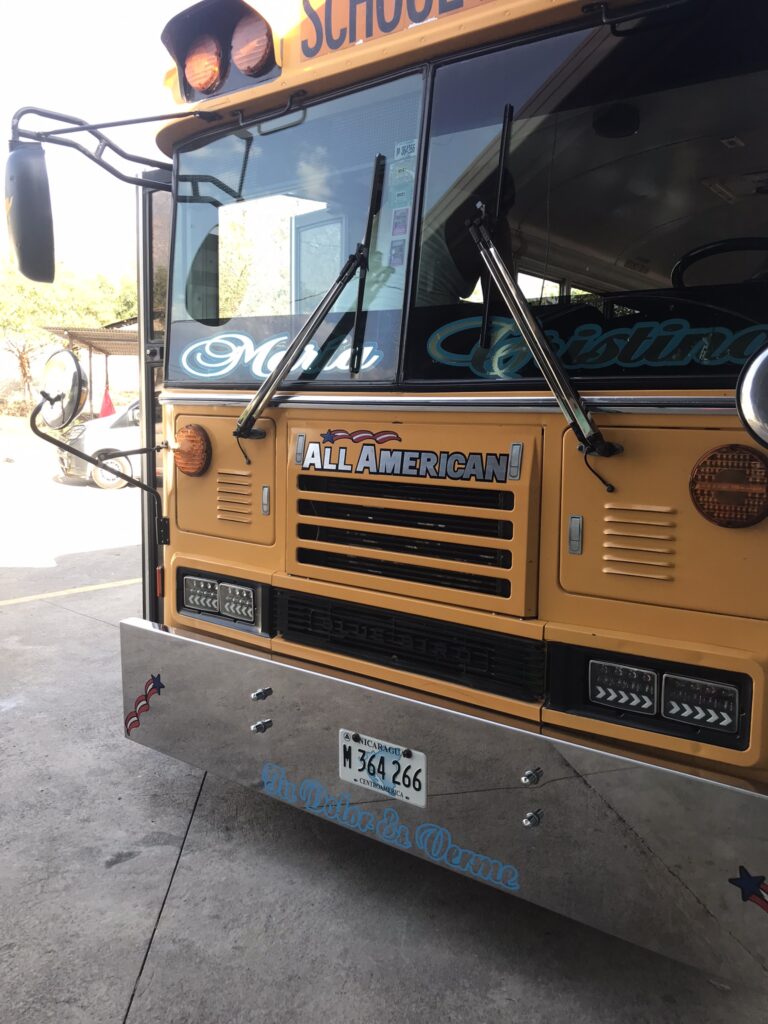
The ‘all-American’ chicken bus in Nicaragua
We took a typical chicken bus from the border to Leon. The rest of our journeys in Nicaragua were made by micros. Micros to most destinations run to and from the ‘UCA terminal’ in Managua (located at co-ordinates 12.126956880659991, -86.27160854684769). These micros are usually direct and are cheaper and faster than any other form of transport in Nicaragua.
Usually the micros in Nicaragua were absolutely crammed full by the time they left, and still the drivers would crawl the streets looking for even more passengers when no more could realistically fit in. In most cases we were able to squeeze our bags into the tiny trunks of the micros, which I’m pretty sure caused damage to the bags. Sometimes we were charged for this and sometimes we weren’t. The micros were not comfortable at all, thankfully most of the journeys we took in the west of Nicaragua were relatively short.
Costa Rica
We found that most of the buses in Costa Rica were coaches rather than chicken buses. The Tracopa company, which runs buses throughout the south and west of Costa Rica, has a website which is easy to navigate and usually the info is accurate, although the buses might be late if coming from other destinations first. Most of the bus terminals in Costa Rica were a little more developed than other countries in Central America, they at least usually had ticket offices and waiting areas.
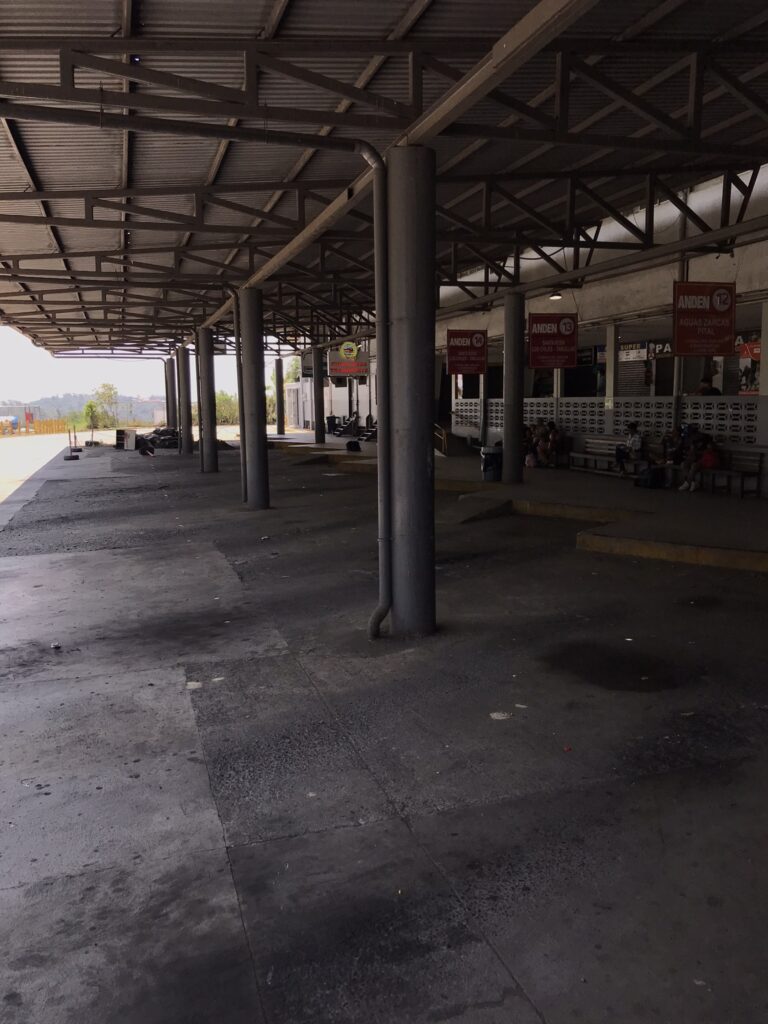
A bus station in Costa Rica, where things are a little more organised
While we found that the Tracopa terminal in San Jose was not too bad, the other bus terminals in San Jose were of poor quality, particularly the Terminal 7-10 which is in a terrible and frankly dangerous part of town. The terminal is also surrounded by scammers both inside and out who provide misleading information about the buses and try to hustle tourists into expensive scam taxis. Terminal 7-10 is one of the worst bus terminals I have experienced anywhere, sadly it is necessary to get to places like La Fortuna in the north of the country. The only good thing is that the terminal had working wifi so we were able to easily get an Uber without leaving the station when arriving after dark.
Panama
We found that the bus station at David was very efficient. It was more like a Tunisian louage station with colectivos and small chicken buses heading for a wide variety of locations, all of which were parked up in an orderly fashion at organised, signposted stops. You could easily get to most places in the west and central parts of the country from here, it was an excellent transport hub.
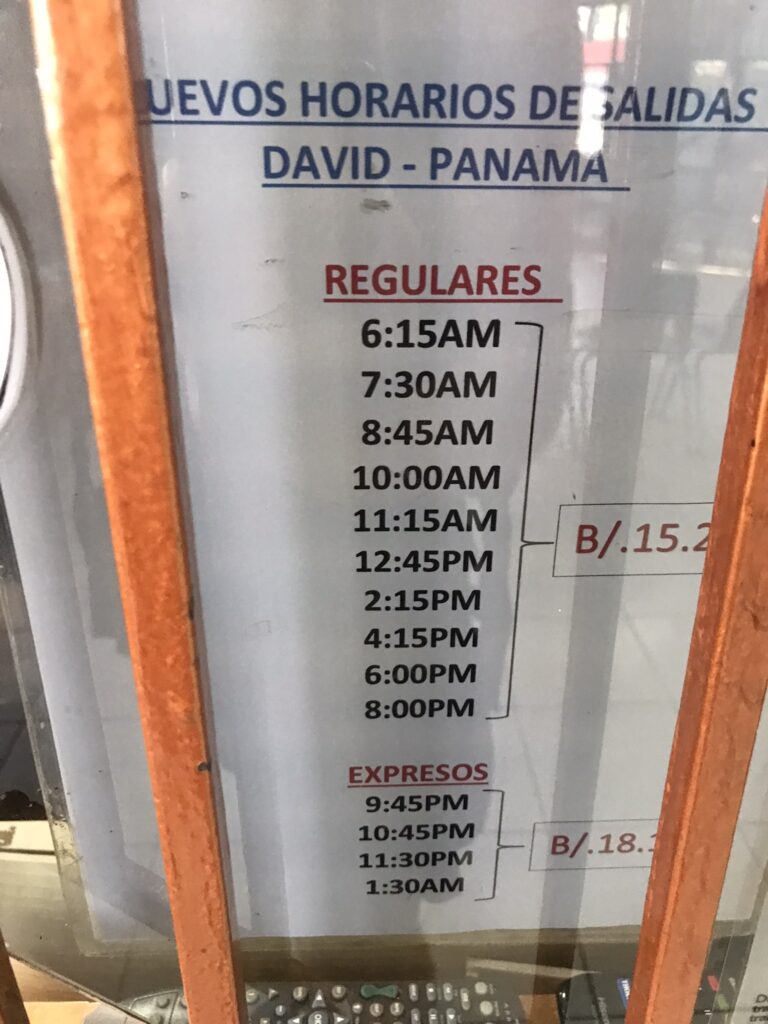
Bus timetables at the terminal in David – a much-appreciated luxury after dealing with the erratic chicken buses in other countries
When heading to Panama City we took a coach from the same bus station in David – the coaches to Panama were running from the end of the bus station, the coach company had a proper ticket office and waiting area and was very professional. The coach into Panama City arrived at the sprawling Albrook terminal, which again is a major transport hub. It is not recommended to walk from this terminal to Casco Viejo or other parts of Panama City, as the terminal is not in a great part of town.
Mexico
Be aware that chicken buses do not really exist in Mexico, at least not for traveling in between major cities. Inter-city bus travel in Mexico is monopolised by major companies such as ADO, Futura and Primera Plus. We found that these companies were professional and reliable (although buses were sometimes late), the service was generally good and safe, terminals were spotless and luggage was looked after, however these buses are not cheap at all. Transport is far, far more expensive in Mexico than elsewhere in Latin America. There were some slightly cheaper ‘second-class’ buses with unreserved seats and people standing on the bus, but they were not significantly cheaper and still really expensive for inter-city travel compared to elsewhere.
We made all of our Central American border crossings by chicken bus and local public transport. Check out my guide to Central American border crossings here!
